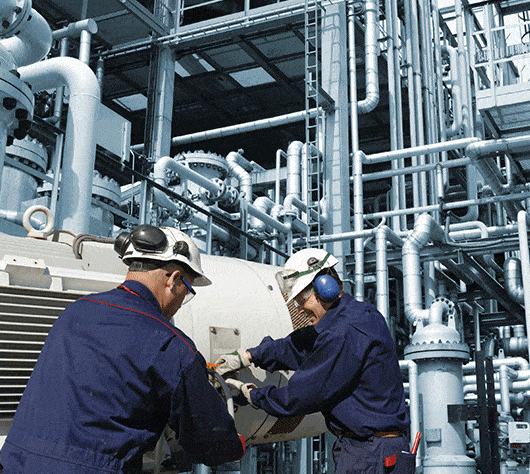Roar Solutions for Beginners
Roar Solutions for Beginners
Blog Article
The Ultimate Guide To Roar Solutions
Table of ContentsRoar Solutions Things To Know Before You BuyIndicators on Roar Solutions You Need To KnowRoar Solutions Fundamentals Explained
In such an atmosphere a fire or explosion is feasible when 3 fundamental problems are met. This is often described as the "harmful location" or "combustion" triangle. In order to safeguard installations from a potential explosion a technique of analysing and classifying a potentially hazardous location is needed. The purpose of this is to make sure the right selection and setup of tools to ultimately protect against an explosion and to ensure safety and security of life.
(https://lnk.pblc.app/pub/f49b043987c7b7)
No equipment needs to be mounted where the surface temperature level of the tools is higher than the ignition temperature level of the offered danger. Below are some usual dust harmful and their minimum ignition temperature. Coal Dirt 380C 225C Polythene 420C (melts) Methyl Cellulose 420C 320C Starch 460C 435C Flour 490C 340C Sugar 490C 460C Grain Dirt 510C 300C Phenolic Material 530C > 450C Aluminium 590C > 450C PVC 700C > 450C Soot 810C 570C The probability of the danger being present in a focus high sufficient to trigger an ignition will differ from location to location.
In order to identify this threat an installation is divided right into locations of threat depending upon the quantity of time the hazardous is existing. These locations are referred to as Zones. For gases and vapours and dirts and fibres there are 3 areas. Zone 0 Zone 20 A harmful ambience is very likely to be present and may be present for extended periods of time (> 1000 hours each year) and even continually Area 1 Zone 21 A dangerous ambience is possible but unlikely to be existing for extended periods of time (> 10 450 C [842 F] A classification of T6 suggests the minimum ignition temperature is > 85 C [185 F] Hazardous area electric devices perhaps created for use in greater ambient temperature levels. This would indicated on the ranking plate e.g. EExe II C T3 Ta + 60C( This implies at 60C ambient T3 will not be surpassed) T1 T1, T2, T3, T4, T5, T6 T2 T2, T3, T4, T5, T6 T3 T3, T4, T5, T6 T4 T4, T5, T6 T5 T5, T6 T6 T6 A T Course score of T1 implies the maximum surface area temperature level produced by the tool at 40 C is 450 C. Presuming the connected T Class and Temperature ranking for the tools are suitable for the location, you can constantly use an instrument with a much more stringent Division ranking than required for the location. There isn't a clear response to this inquiry. It really does rely on the kind of equipment and what repair work require to be accomplished. Devices with specific test procedures that can't be done in the area in order to achieve/maintain third party score. Must come back to the manufacturing facility if it is prior to the equipment's solution. Area Repair Work By Authorised Employee: Complicated screening might not be called for nonetheless details treatments may need to be adhered to in order for the devices to preserve its 3rd party ranking. Authorized employees have to be utilized to perform the job properly Repair service must be a like for like replacement. New element have to be taken into consideration as a direct replacement needing no unique testing of the tools after the repair service is full. Each item of equipment with a harmful ranking ought to be assessed individually. These are laid out at a high level below, but also for even more in-depth details, please refer straight to the standards.
8 Simple Techniques For Roar Solutions
The tools register is a comprehensive data source of devices documents that consists of a minimum collection of areas to recognize each item's location, technical parameters, Ex category, age, and environmental data. The proportion of In-depth to Shut evaluations will be established by the Tools Threat, which is examined based on ignition danger (the possibility of a resource of ignition versus the possibility of a combustible ambience )and the harmful location classification
( Zone 0Area 1, or 2). Carrying out a durable Risk-Based Examination( RBI )technique is critical for making certain conformity and security in taking care of Electric Devices my review here in Hazardous Areas( EEHA).
The Ultimate Guide To Roar Solutions

In regards to explosive danger, a hazardous area is an environment in which an eruptive ambience exists (or might be anticipated to be existing) in quantities that require unique preventative measures for the building, installment and usage of devices. electrical refresher course. In this post we check out the obstacles encountered in the work environment, the risk control steps, and the required expertises to work securely
These compounds can, in specific problems, develop explosive atmospheres and these can have major and terrible effects. Most of us are acquainted with the fire triangular eliminate any type of one of the 3 components and the fire can not take place, yet what does this mean in the context of harmful areas?
In many instances, we can do little regarding the levels of oxygen airborne, but we can have significant influence on resources of ignition, for instance electrical tools. Unsafe areas are documented on the hazardous location classification drawing and are identified on-site by the triangular "EX LOVER" indicator. Below, among various other crucial info, zones are divided right into three types relying on the hazard, the probability and duration that an eruptive atmosphere will exist; Zone 0 or 20 is regarded the most dangerous and Area 2 or 22 is deemed the least.
Report this page